
* Although cargolift aircraft don't have the glamour of fighters and bombers, they are still an important element in military operations, and have interesting features and history of their own. Three of the more important European cargolifter aircraft of the postwar period were the piston-powered French Nord "Noratlas"; plus its successors, the turboprop-powered Franco-German Transall "C-160", and the Italian Alenia "G222" . This document provides a history and description of the Noratlas, C-160, and G222.
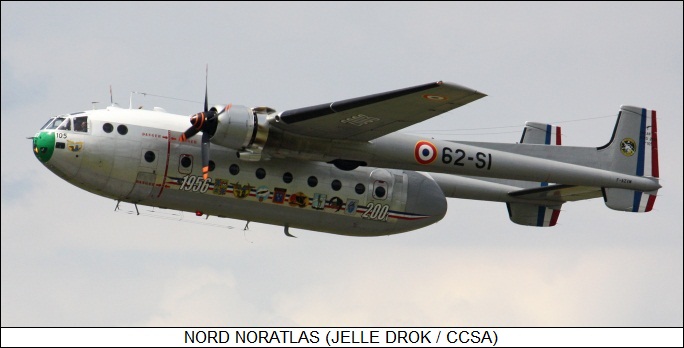
* In the late 1940s, the French SNCA du Nord company began work on a cargolifter to replace the Douglas C-47s and Junkers Ju 52s then in French service. The company came up with a design, the "Nord 2500", with dual piston engines and the twin-boom arrangement of the American Fairchild C-82 Packet cargolifter. The N-2500 was powered by two SNECMA-built Gnome-Rhone 14R radial engines with 1,195 kW (1,600 HP) each, and first flew on 10 September 1949.
The Nord 2500 prototype left something to be desired, and led to the improved "Nord 2501", powered by two SNECMA-built Bristol Hercules 738 or 758 radials with 1,520 kW (2,040 HP) each. The Nord 2501 first flew on 10 September 1949. It proved more satisfactory and the French air force, the Armee de l'Air (AA), ordered three pre-production examples of the type, with the first performing its initial flight on 10 September 1952. The AA followed up with an order for an initial production batch of 40 N-2501s, with the last of the batch delivered at the end of June 1954. The AA ordered further batches, ultimately obtaining a total of 200 N-2501s.
The Noratlas flew with a flight crew of four or five, and could carry 45 troops; 31 paratroops with drop gear; 18 stretchers with medical attendants; or 6,800 kilograms (14,900 pounds) of cargo. The AA N-2501s saw combat service in Algeria, and during the Suez conflict of 1956. A few remained in AA service into the 1970s.
___________________________________________________________________
NORD N-2501 NORATLAS:
___________________________________________________________________
wingspan:
32.5 meters (106 feet 8 inches)
wing area:
101.2 sq_meters (1,089 sq_feet)
length:
22 meters (72 feet 1 inch)
height:
6 meters (19 feet 8 inches)
empty weight:
13,300 kilograms (28,670 pounds)
max loaded weight:
22,000 kilograms (48,500 pounds)
max cruise speed:
335 KPH (208 MPH / 181 KT)
service ceiling:
7,500 meters (24,600 feet)
range:
2,500 kilometers (1,550 MI / 1,350 NMI)
___________________________________________________________________
* The West German Luftwaffe also adopted the Noratlas, beginning operations with the type in 1958. 25 were assembled in Germany from kits supplied by Nord, and 161 more were built in Germany -- the details of German construction are obscure, some sources claiming the work was done by "Flugzeugbau Nord", a satellite firm set up in Germany by Nord specifically to build the Noratlas; while others claim it was done by a purely German firm named "Flugzeugwerke Nord". In any case, these aircraft were designated "N-2501D".
The Israelis bought 30 "N-2501IS" machines, generally similar to the standard N-2501. The Israelis were forced to buy their first batch of three Noratlas transports as a condition of a sale of twelve Dassault Ouragan fighters. The Israelis were unhappy at first about being pressured to buy the transports, but came to appreciate their usefulness. The Noratlas served Israel in the Suez conflict in 1956, the Six-Day War in 1967, and the Yom Kippur War in 1973. They were used not only for cargo transport and paratroop drop, but for maritime patrol. The Israeli machines were finally retired in 1978.
Portugal bought 12 N-2501s. Used French and German aircraft were bought by Niger (4), Nigeria (6), Chad (10), and Greece (40). Some N-2501s remained in civilian service into the 1990s.
* Some other variants of the Noratlas were proposed or built in small numbers:
The "N-2505", N-2507", "N-2509", and "N-2510" were paper projects only, and never flew. Total Noratlas production came to 425 aircraft.
BACK_TO_TOP* The Nord Noratlas was a fine and useful aircraft, but of course there came a time when its users wanted something better as a replacement. In January 1959, this desire translated into the formation of the "Transporter Allianz (Transall)", a joint group formed of Aerospatiale of France, along with Messerschmitt-Boelkow-Bohm (MBB) and VFW-Fokker of Germany. There was an attempt to get the Italians involved, but they didn't join up.
The result of this alliance was the "Transall C-160" transport, with three prototypes built, one by each manufacturer in the group. The first prototype flew on 25 February 1963. This led to six preproduction "C-160A" machines, with initial flight in 1965, these aircraft featuring a fuselage stretch of 51 centimeters (20 inches) relative to the three prototypes. Three of the C-160As were evaluated by the AA, while the other three were evaluated by the Luftwaffe. Similar production machines followed, beginning in 1967. The C-160 was one of the first successful multinational European aircraft development programs.
* The C-160 was a neat, competently designed transport of conventional modern cargolifter configuration. It was a high-wing, twin-engine aircraft, fitted with license-built Rolls-Royce Tyne Mark 22 turboprops providing 4,550 kN (6,100 EHP) each, driving four-bladed paddle-style propellers 5.49 meters (18 feet) in diameter. Cargo was handled through a hydraulically-operated loading ramp under a high-mounted tail, and there were two passenger loading doors with built-in steps on the left side of the fuselage.

The C-160 was fitted with tricycle landing gear, with the 2-by-2-wheel main gear assemblies retracting into sponsons alongside the fuselage, leaving the interior cargo area unobstructed. The landing gear was designed for operation from rough airstrips, and its height could be adjusted on the ground to ease cargo loading. Double slotted flaps were fitted to the wing for short take-off capability, while spoilers mounted on top of the wing and reversible propeller operation helped reduce landing roll. There was also provision for attaching a booster turbojet with thrust reverser under each wing, but it does not appear that this option was ever implemented.
___________________________________________________________________
TRANSALL C-160:
___________________________________________________________________
wingspan:
40 meters (131 feet 3 inches)
wing area:
160.1 sq_meters (1,723.4 sq_feet)
length:
32.40 meters (106 feet 4 inches)
height:
11.65 meters (38 feet 3 inches)
empty weight:
29,000 kilograms (19,975 pounds)
MTO weight:
51,000 kilograms (112,435 pounds)
max speed:
513 KPH (319 MPH / 277 KT)
service ceiling:
8,230 meters (27,000 feet)
range:
1,850 KM (1,150 MI / 1,000 NMI)
___________________________________________________________________
The C-160 had a crew of four and could carry 93 troops, all in pressurized accommodations; or 81 fully equipped paratroops; or 62 litters with four medical attendants; or a maximum of 16,000 kilograms (35,275 pounds) of cargo. The cargo bay featured a winch and a roller system, and the floor had tie-down attachments for securing the cargo.
* Initial production of the C-160 consisted of 110 "C-160Ds" for the West German Luftwaffe; 50 "C-160Fs" for the French AA; and 9 "C-160Zs" for South Africa. Four of the French C-160Fs were later converted for operation as mail carriers for Air France, and redesignated "C-160P". 20 of the German C-160Ds were passed on to Turkey as "C-160Ts".
The last of initial C-160 production was completed in 1972, but in 1977 production was reinstated of an improved version, the "C-160 Nouvelle Generation (NG / New Generation)" for France. These machines featured:
Initial flight of the first C-160NG was on 9 April 1981. A total of 25 was initially ordered. Of these, ten were configured as inflight refueling tankers with hose-and-drogue gear in the left sponson, with five more having provisions for such gear.
Four more C-160NGs were ordered, for a total of 29, with these final four machines configured with the Rockwell Collins "Take Charge And Move Out (TACAMO)" VLF radio system, the same as that used on the US Navy's Boeing E-6A TACAMO platform. The radio system was intended for communications with submerged ballistic missile submarines through a pair of long wire antennas weighted to hang down from the aircraft while it flew in slow circles. These C-160s were designated the "C-160H Avion Station Relais de Transmissions Exceptionales (ASTARTE)". They featured the refueling probe and, interestingly, the hose-and-drogue tanker kit. Initial delivery of this subvariant to the AA was in 1987, with introduction to service in 1988.
Two C-160NGs were also converted to the "C-160G Gabriel" SIGINT and jamming configuration to replace the older Noratlas N.2501 Gabriel platforms. The C-160Gs were littered with antennas and antenna fairings, including wingtip pods for an "electronic support measures (emitter locator)" system; a "farm" of five blade antennas on top of the forward fuselage; a retractable dome under the forward fuselage; and a blister on each side of the rear fuselage. As with the C-160H Astarte, the two C-160Gs were configured with both refueling probe and hose kit. The C-160Gs saw service in the Gulf War in 1991 and in later conflicts.
* Transall also proposed conversion kits to create several other variants of the C-160 that were never built:
* In the late 1990s, all 66 C-160 transport variants surviving in AA service were given an avionics update, including a Global Position System receiver with inertial navigation system backup, a head-up display, and other kit, and redesignated "C-160R", where the "R" stood for "Renove / Renovated". 22 C-160Rs were then upgraded with a self-defense suite including a radar-warning receiver, missile warning system, and chaff-flare dispensers. The ASTARTE and Gabriel special mission-aircraft were given the same sets of upgrades under a separate program.
The Gabriels received a SIGINT system upgrade a decade later. They were finally retired in the spring of 2022, their last missions having been monitoring the Russian invasion of Ukraine. They will be replaced from 2025 by three Dassault Falcon 8X business jet, under the "Avions de Renseignement a Charge Utile de Nouvelle Generation (ARCHANGE / Intelligence Aircraft With Next-Generation Payload)".
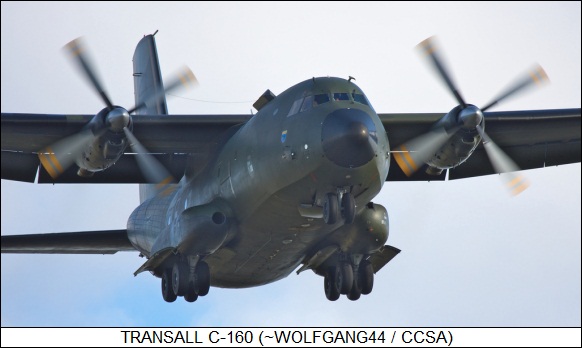
The Luftwaffe fleet similarly underwent a service-life extension program in the early 1990s. A component of the German Transalls was dedicated to special operations support, these machines being fitted with modernized flight system / navigation avionics, and cockpits compatible with night vision goggles (NVGs). However, both the French and German Transalls will be out of service by the end of the decade, being replaced by other types of transports, most significantly the Airbus A400M. The Turks were still operating their C-160s at last notice, but the South African machines have been retired.
BACK_TO_TOP* The Italians developed their own answer to the C-160, but the route they took to get there was more roundabout. In 1962, NATO released a "NATO Basic Military Requirement 4 (NBMR4)" request for a vertical or short take-off and landing (VTOL/STOL) medium transport for NATO armed forces. The exercise proved to be mostly one of futility, since none of the proposals submitted were judged acceptable.
However, the Aeronautical Militaire Italiana (AMI / Italian Air Force), was interested in Fiat's NBMR4 proposal -- a twin-turboprop cargolifter of generally conventional configuration, except for sets of "liftjets" in each engine nacelle, plus lift fans in the tail and wingtips -- as a replacement for the service's old Fairchild C-119 Boxcars. The AMI didn't want the VTOL fixtures, but otherwise the design seemed to fit service needs. That led in 1968 to the award of a contract to Fiat for three prototypes of the "G222TCM" medium tactical transport, including two flying prototypes and a static test machine.

The development program proved troublesome and the first prototype didn't fly until 18 July 1970. The second prototype performed its first flight on 22 July 1971. The AMI's evaluations rated the G222 very highly, resulting in a production contract to Aeritalia -- which Fiat's aircraft group had become in the meantime, with the organizational change contributing to the development delays. There were further delays when the machine was redesigned to use more powerful engines, but the first production machine finally performed its first flight on 23 December 1975.
The G222 was of conventional modern cargolifter configuration, with a high wing, a tail loading ramp, and main landing gear stowed in sponsons alongside the lower fuselage to provide an unobstructed cargo bay. The wing outer panels had a dihedral of 2.5 degrees; the wing featured ailerons and double slotted flaps inboard, the flaps covering 60% of the trailing edge. The flaps were split by the engine; there was a two-section spoiler in front of the outboard flap, with the spoiler used for roll control and as a lift dumper. The ailerons were manually actuated, while the flaps and spoilers had hydraulics; the elevators were manually controlled, while the rudder was hydraulically driven. The nose gear had two wheels, while each main gear assembly had tandem wheels.
There was an "airstair" passenger door forward on the left, matched by an emergency exit on the right; an inward-opening door on each side in the rear for parajumping; and a two-piece tail door featuring a lower ramp and upward swinging door, both hydraulically actuated. The tail door could be opened in flight for airdrops. The aircraft was powered by two General Electric T64-GE-P4D turboprop engines, built under license by Fiat; the engines were rated at 2,535 kW (3,400 SHP) each, driving three-blade reversible propellers. The T64 was originally designed as a helicopter turboshaft, most significantly being used on the Sikorsky S-65 & S-80 helicopters. There was an auxiliary power unit (APU) in the G222's right landing gear sponson for engine starting and ground power.
The G222 was pressurized. The two flight prototypes were unpressurized and had CT64-GE-820 engines with 2,140 kW (2,870 HP) each. There were fuel tanks in the outer wings and wing center section, providing a total fuel storage of 12,000 liters (3,170 US gallons). All flight surfaces had leading-edge pneumatic deicing boots, while the props and engine inlets were electrically deiced.
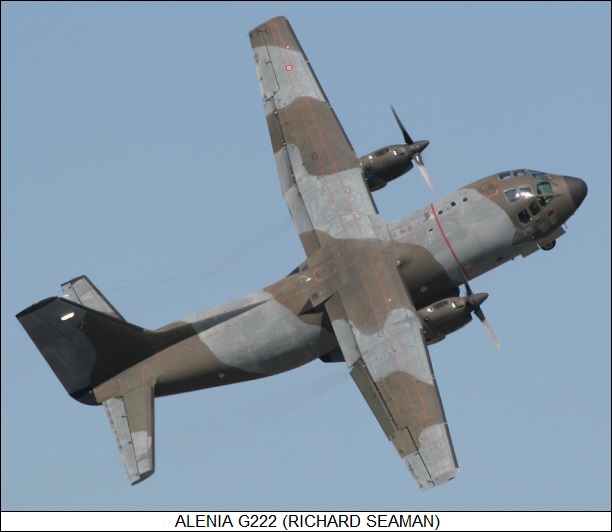
Avionics included Meteo weather radar in the nose featuring a secondary ground mapping capability, along with radios, radio navigation aids, and an identification friend or foe (IFF) transponder. There were two aircrew, with a jumpseat for a third. Maximum cargo capacity was 9,000 kilograms (19,840 pounds), and the cargo bay could be fitted with a hoist with a capacity of 1,500 kilograms (3,300 pounds). There were 135 tie-down points in the cargo deck. In troop transport configuration, the G222 had 34 sidewall seats and 12 folding center seats, providing accommodation for 46 fully equipped troops. In the paratroop role, the center seats couldn't be used, limiting the G222 to 32 paratroopers. It could also carry 36 stretchers and two seated casualties, along with four attendants.
___________________________________________________________________
AIRITALIA G222:
___________________________________________________________________
wingspan:
28.7 meters (94 feet 2 inches)
wing area:
82 sq_meters (882.6 sq_feet)
length:
22.7 meters (74 feet 6 inches)
height:
9.8 meters (32 feet 2 inches)
empty weight:
15,400 kilograms (33,950 pounds)
loaded weight:
28,000 kilograms (61,730 pounds)
max speed at altitude:
540 KPH (335 MPH / 290 KT)
cruise speed:
440 KPH (275 MPH / 240 KT)
loaded take-off length:
1,000 meters (3,280 feet)
service ceiling:
7,620 meters (25,000 feet)
loaded range:
2,500 kilometers (1,560 MI / 1,350 NMI)
___________________________________________________________________
* 30 standard G222 military transports were obtained by the AMI, and the variant was also sold in small numbers to Argentina, Dubai, Nigeria, Somalia, Thailand, and Venezuela. The G222 was also bought by Libya, but the US embargo against that country meant that the GE engines couldn't be used, and so the machine was redesigned to use the British Rolls-Royce Tyne powerplant. This particular variant was designated "G222T" by Aeritalia and "G222L" by the Libyan Air Force, which obtained 20, including two in VIP configuration.
The Tyne was more powerful than the T64, with 2,535 kW (3,400 SHP), but had higher fuel consumption. The new engine fit required modification of the engine nacelles, and the landing gear was reinforced to handle the higher gross weights permitted by the new engines. The Tyne's greater fuel consumption meant greater fuel weight in principle, but the engine also permitted flight at higher altitudes, of up to 9,150 meters (30,000 feet), and more economical cruise. The G222L actually had longer range than the standard G222, even though it had an empty weight 3,400 kilograms (7,500 pounds) greater.
A number of specialized versions of the G222 were developed for Italian service:
Other specialized variants, for such diverse applications as maritime patrol; airborne early warning (AEW); crop spraying; earth resources mapping; drone launch and control; and inflight refueling were proposed, but never built.
In 2010, the US Air Force awarded a contract to Alenia -- formed by a 1990 merger of Aeritalia and Selenia -- to refurbish 20 old AMI G222s for use by the Afghan Air Force. Deliveries were in 2010, but the aircraft never entered operational service, and in 2014 16 of them were simply scrapped, with four survivors flown to Ramstein Air Force Base in Germany.
BACK_TO_TOP* The US Air Force (USAF) selected the G222 in August 1990 for that service's "Rapid Response Intra-Theater Airlifter (RRITA)" requirement, winning over the Airtech CN-235. The USAF obtained an initial batch of five, with thirteen more purchased later, for a total of 18. The type is designated "C-27A Spartan" in USAF service. The prime contractor for the order was Chrysler, which obtained the machines from Alenia stripped of avionics and with minor changes from the stock configuration -- including an antiskid braking system, a modified cargo compartment, and a crew oxygen system. Chrysler then fitted them with systems as specified by the Air Force, including an avionics suite in a modified cockpit; a loadmaster's position; and provision for medical equipment, including a power converter to provide 60 hertz AC power from the aircraft's 400 hertz electrical system.
All the C-27As were operated for the US Army Southern Command, with its domain of operations in Latin America. The C-27As could fly from 90% of the airports in Latin America, while the C-130 Hercules cargolifter could only operate from 10% of them. It was sometimes called the "Half-Hercules", since it had about half the load capacity of the C-130. However, changing commitments and the cost of operating the Spartans led to the fleet being retired in 1999. At least four ended up in the hands of the US State Department, being used in support of anti-narcotics operations in South America.
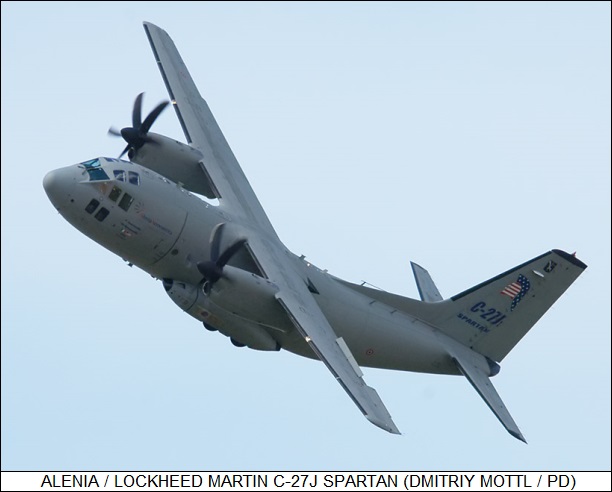
* A few years later, Alenia partnered with Lockheed Martin to develop an update of the G222 / C-27A, the "C-27J". Improvements in the updated machine included:
The collaboration between Alenia and Lockheed Martin on the C-27J began in 1995, with the joint operation begun the next year and named "Lockheed Martin Alenia Tactical Transport System (LMATTS)". There were three C-27J prototypes. The first was a converted G222, and performed its first flight on 24 September 1999; the second was a full new-build aircraft, while the third was a converted AMI G222 and used for military certifications. The C-27J received both military and commercial certifications in 2001.
The AMI ordered 12 C-27Js, with deliveries from 2005. In that year, Lockheed Martin bailed from the program for whatever reasons, transferring the US element of the partnership to L3 Communications, with the new arrangement named "Global Military Aircraft Systems (GMAS)". The Greek Air Force also selected the type and bought 12, with four fitted out with tanker inflight refueling probes, and a number with strengthened floors.
The Bulgarian Air Force ordered five in 2006, though the order was cut to three, with these aircraft featuring defensive countermeasures kit. Lithuania and Kenya bought three, Romania seven, Morocco four, Mexico and Peru four each as well, Slovakia two, Zambia two, and Slovenia two. Some users obtained a plug-in VIP transport module that could accommodate 29 passengers.
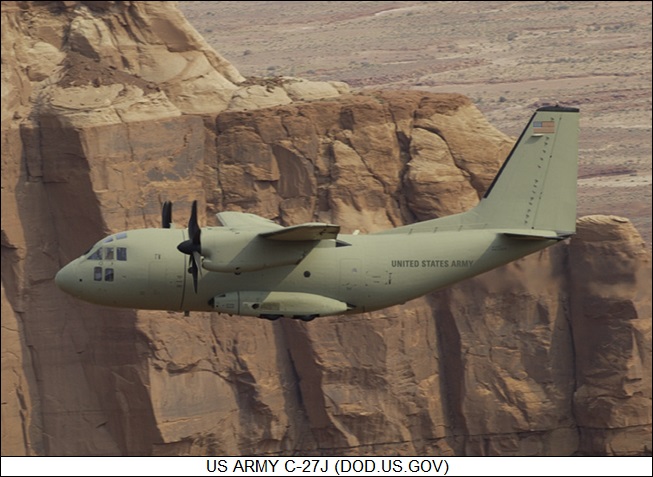
The C-27J achieved what seemed at the time like a particular success by being selected for the US military's Joint Cargo Aircraft (JCA) program, but it more or less turned out to be a booby prize. At the outset, 78 aircraft were to be obtained, but the buy was trimmed to 38 machines in 2010, ending plans for assembly in a US-based factory. The Army originally planned to fly the C-27Js, but the Air Force got the mandate, farming it out to the Air National Guard -- and then retired them all in 2012, stating they were more expensive to operate than C-130s. Presumably, they just weren't a good fit to mission requirements.
Seven were obtained by the US Special Operations Command for parachute training, while 14 were snapped up by the US Coast Guard for maritime patrol / SAR. The Coast Guard machines are being upgraded with a standardized "Minotaur Mission System (MMS)" -- to also be used on the Lockheed Martin HC-130J Hercules and Airbus HC-144 Ocean sentry -- featuring a search radar, electro-optical / infrared sensors, a central processor, and software linking the system together. L-3 Communications was contracted to do the work.
The first "HC-27J" Coast Guard machine, in the service's white-&-orange "creamsicle" colors, went into operational service in April 2016, with the last deliveries in 2017. They were not up to full operational specification at the outset, with the machines to later be fitted with the Telephonics AN/APS-143(v)3 multimode radar and other avionics updates. The fleet is expected to be up to full operational standard by 2023.
The details of the C-27J fiasco remain completely unclear, obviously because nobody wants to or dares talk about it. More encouragingly, in 2012 the Royal Australian Air Force ordered 10 C-27Js to replace de Havilland Caribous that were retired in 2009. The first Aussie C-27J was delivered in 2015, the last in 2018; these machines were fitted out in the US to the same spec as the USAF C-27Js. The Aussies don't compare the C-27J to the Hercules, instead regarding it as a "fixed-wing Chinook", neatly matching the Boeing CH-47 that has a long tradition in Australian service.
After test flights, Leonardo -- which absorbed Alenia Aermacchi in 2016 -- worked on development of a removeable inflight refueling tanker kit, and there is thought of building a stretched version of the aircraft, with fore and aft fuselage plugs to increase length by 3 meters (10 feet) and raise troop capacity to 64. There have been considerations of a special operations transport variant, featuring armor; a laser-based defensive countermeasures system; a forward looking infrared (FLIR) imager to permit low-level flight at night; and pilot helmet-mounted displays.
Leonardo has also worked with Alliant Techsystems (ATK) on a "multimission" configuration named the "MC-27J", capable of being adapted to different roles through use of palletized systems. One palletized element is an ATK GAU-23 30-millimeter chain gun cannon, having been demonstrated with a simple optical sighting system handled by the pilot. The MC-27J would also carry sensors, typically an undernose electro-optic / infrared imaging turret, and could dispense lightweight munitions, such as the Raytheon Griffin missile, out the open rear ramp. Modified rear doors with launch tubes are a possibility as well, permitting launches of such weapons without depressurizing the cabin. Initial flight of a demonstrator, with an undernose imaging turret but no weapons at the outset, was in the spring of 2014.
In 2013 the AMI -- on behalf of the Comando Operativo Forze Speciali (COFS) / Italian Special Forces -- requested the development of a "Praetorian" subvariant of the MC-27J for the COFS, with three existing C-27Js brought up to Praetorian configuration, and three more being wired up to accept palletized weapon systems should the need arise. These will be the first gunship cargolifters to be operated by a European air arm. They will complement another special mission C-27J operated by the Italians that carries jammer gear to deal with radio-operated "improvised explosive devices". All will be deployed by 2030.
In 2020, the European SCODEV (Scooping Device) Alliance introduced a "roll-on roll-off" fire-attack system (FAS) for the C-27J that could deliver 10,600 liters (2,795 US gallons) of water and 568 liters (150 US gallons) of foam onto a fire. The C-27J could refill the water tank by flying low over a body of water, and dropping a dragline. The water / foam was dumped through ducts in the paratrooper doors in the rear sides of the aircraft. The FAS required minor cockpit control updates.
Following up on this development, in 2022 Leonardo announced the "C-27J Next Generation" -- which featured:
In 2023, Italy began an upgrade program to refit existing C-27Js with the new avionics and countermeasures.
The C-27J NG is being promoted as a multi-role aircraft, not merely for airlift and fire-fighting, but also as an intelligence / surveillance / reconnaissance platform, and as a maritime patroller for surface or antisubmarine warfare missions. The C-27J NG has three stores pylons on each outer wing for antiship missiles, torpedoes, or other payloads.
Two have been obtained by Turkmenistan, two by Slovenia, one by Azerbaijan, and two by Tanzania. The Tanzanian C-27Js were in good part obtained for fire-fighting, though they also had humanitarian and SAR roles as well.
BACK_TO_TOP* An acquaintance once told me that the Noratlas was a "bizarre" machine, but I find it has a comfortable appearance. I used to see the similar Fairchild C-119 Boxcar flying around my hometown very often when I was little, and the Noratlas brings back plenty of memories.

* Sources include:
* Revision history:
v1.0.0 / 01 nov 02 v1.0.1 / 01 nov 04 / Review & polish. v1.0.2 / 01 nov 06 / Review & polish. v1.0.3 / 01 apr 08 / Review & polish. v1.0.4 / 01 mar 10 / Review & polish. v1.0.5 / 01 feb 12 / Review & polish. v2.0.0 / 01 jul 13 / Folded in Alenia G222. v2.0.1 / 01 jun 15 / Italian Special Forces obtains MC-27J. v2.0.2 / 01 may 17 / Review & polish. v2.0.3 / 01 apr 19 / Review, update, & polish. v2.0.4 / 01 feb 21 / Review, update, & polish. v2.0.5 / 01 dec 22 / Review, update, & polish. v2.0.6 / 01 nov 24 / Review, update, & polish. (*)BACK_TO_TOP
